Fujifilm XQ1 Review
Fujifilm XQ1 Introduction
The Fuji XQ1 is a premium digital camera in a compact body featuring Fuji's unique X-Trans CMOS II sensor with built-in Phase-Detect AF. Packed with features including full manual-controls, manual-focus and custom white-balance, the XQ1 makes these more accessible than any compact camera with dual control-dials and an traditional exposure mode-dial.
Its ultra-wide-angle 4X optical zoom lens has an ultra-bright F/1.8 maximum aperture which dims to F/4.9 at the telephoto end. This retractable lens offers an equivalent 25-100mm focal-range and optical image-stabilization.
The 12 megapixels sensor of the Fuji XQ1 has an ISO range of 100 to 12800 at full-resolution. Its X-Trans 6x6 color-filter-array resolves details without suffering from moire artifacts and therefore does not use an anti-alias filter like nearly every other fixed-lens camera.
This camera review covers the usability and performance of the Fuji XQ1.
Fuji XQ1 Features
Sensor
- 12 Megapixels 2/3" X-Trans CMOS II Sensor
- No Anti-Alias filter
- 49-Point Hybrid Phase-Detect AF
- ISO 100-12800 with 100% Dynamic-Range
- ISO 200-3200 with 200% Dynamic-Range
- ISO 400-3200 with 400% Dynamic-Range
- Automatic ISO up to 400-3200
- JPEG, RAW or JPEG+RAW Output
- 1920x1080 @ 60 FPS 16:9 HD Video
- 640x480 @ 80 FPS 4:3 SD Video
- 320x240 @ 150 FPS High-Speed Video
- 320x112 @ 250 FPS High-Speed Video
Lens
- Fujinon 25 - 100mm equivalent lens
- Bright F/1.8 - 4.9 maximum aperture
- F/1.8 - 11 Aperture range, 1/3 EV stops
- Optical Image Stabilization
- 3cm Minimum focus distance at 25mm
- 50cm Minimum focus distance at 100mm
Exposure
- PASM Exposure modes
- 1/4000s - 30s Shutter-speed
- Exposure-Compensation, ±3 EV, 1/3 EV steps
- Flash-Compensation, -2/3...+2/3, 1/3 EV steps
- Multi-Segment, Spot & Average metering
- AEB, 3 Frames, ±1 EV, 1/3 steps
- ISO Bracketing, ±1 EV, 1/3 steps
- Film Simulation Bracketing
- Dynamic Range Bracketing
- Fixed 1/3 EV exposure steps
Viewfinder & Displays
- 3" LCD, 920K Pixels, 100% coverage
- Digital-Level, Tilt axis only
Focus & Drive
- Auto or Single or Tracking focus-point selection
- Single-Shot, Continuous or Manual Focus
- 12 FPS Drive, Max 8 JPEG
- Motion Panorama, 360°, 180° & 120°
- Multiple-Exposure, 2 frames
- Multi-Frame Noise-Reduction
- Multi-Frame Background Blur simulation
- 2s & 10s Self-Timers
- Optional AF-Assist lamp
- Optional Face-Detect AF
- Optional Focus-Peaking
Images Parameters
- Automatic, Preset, Kelvin and Custom WB
- WB fine-tuning, 19-steps along 2-axis
- Film Simulation: Provia, Velvia, Astia, B&W
- Adjustable color-saturation, 5 steps
- Adjustable sharpness, 5 steps
- Adjustable highlight-tone, 5 steps
- Adjustable shadow-tone, 5 steps
- Adjustable noise-reduction, 5 steps
Body & Construction
- Dual Control-Dials
- Customizable E-Fn button
- Video-Record button, no dedicated mode
- Built-in flash, 7.4m (W) - 2.7m (T) reach
- Metal tripod mount
- Built-in WiFi, 802.11b/g/n
- Analog NTSC/PAL output
- 1080i HDMI output
- USB 2.0 connectivity
- SDXC memory-card slot
- Proprietary Lithium-Ion battery
- Internal USB charging
Fujifilm XQ1 Usability - How easy is it to use?
The Fuji XQ1 has a simple rectangular design with a short protruding lens barrel surrounded by a control-ring. When powered on, its lens extends another 3-4cm from the control-ring. This camera is quite small and barely larger than an ultra-compact. The body is relatively sturdy yet buttons have a plasticky feel to them.
The front of the XQ1 is completely smooth and there is no hint of a hand-grip. A small rubber thumb-rest at the back provides some purchase but do use the supplied wrist-strap as this camera is slippery. A tiny button at the top is used to turn the camera on or off. The camera can also be powered into Playback mode by holding down the Play button for 2 seconds. Pressing it again from there turns the camera off.
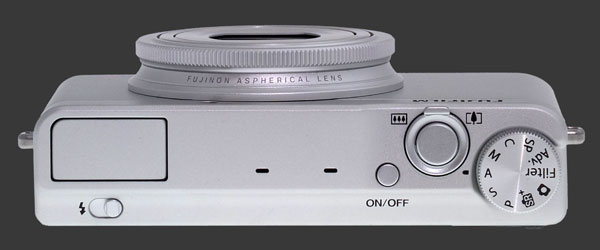
The top plate has several items of interest. Starting at the left, there is a typical popup flash which is released by a spring-loaded switch behind it. Towards the center of the camera, two small holes form a stereo microphone used for recording audio with video.
Further right, one can see the power button mentioned earlier. A standard two-stage shutter-release with wrap-around zoom-control is next to it. The zoom moves from ultra-wide angle towards telephoto with a small pause between two levels of digital zooms. Unfortunately, this cannot be disabled. So, you may accidentally degrade image-quality if not paying sufficient attention while zooming.
A standard mode-dial with 10 positions is located at the edge of the top-plate. The traditional PASM modes are all there, plus one Custom mode, two Auto modes, a Filter mode and positions which group various automated modes. The first one, labelled Adv, offers some interesting options, while the latter holds Scene modes.
The standard Auto mode, indicated by a camera icon, is rather typical and locks all settings other than the Self-Timer, a subset of Drive-Modes, Macro and AF Mode. This makes the XQ1 one of the rare compacts which can be focused manually even in Auto mode.
The second automatic mode is labelled SR+ which stands for Scene Recognition Plus. While in this mode, the XQ1 constantly tries to determine the type of scene in front of it. Autofocus is fixed to continuous (AF-C) which is audible and drains the battery rapidly. This one is impressive but not as adaptive as Auto EXR mode on some other Fujis.
The Advanced modes are:
- Motion Panorama 360: Sweep the scene in any horizontal or vertical direction to create a panorama spanning 120°, 180° or 360°. A cylindrical 360° option tries to make the ends blend seamlessly.
- Pro Focus: Blends two exposures to simulate shallow depth-of-field.
- Pro Low-Light: Blends four exposures to reduce image noise.
- Multiple Exposure: Overlays two exposures. Fuji always offered an excellent implementation for Multiple-Exposure and the XQ1 is no exception. One can take a shot and retry until the desired result is achieved. While taking the second image, the previous one is overlaid, making matching features quite easy.
The SP position groups all Scene modes for those intimidated by manual-controls. There are 14 of those, with two Night modes which usefully distinguish between hand-held and tripod use.
Notably lacking from the mode-dial is a video-mode. Shame on Fuji, the X10 has one! Instead there is a Video-Record button on the rear which starts filming two seconds later and stops one second after being pressed. At least, optional HD guidelines can help frame video but to see them one has to chose the right guides, enable them in the custom view and switch to the custom view as well.
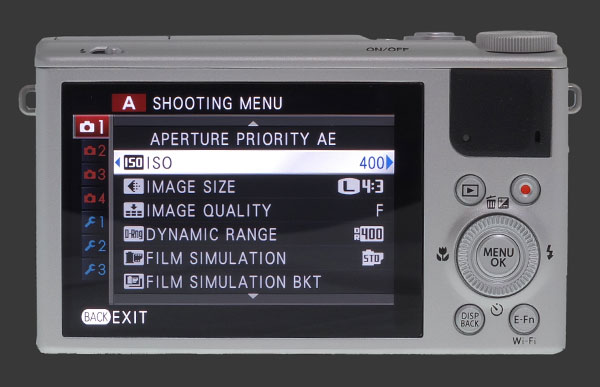
All remaining controls are found on the back of the camera, packed to the right of a 3" LCD with 920K pixels. The display is crisp with an excellent refresh rate. It has great outdoor visibility normally and a special Sunlight mode which turns it very bright to improve visibility in harsh light. There is an option to make the display Exposure-Priority in Manual mode only. In all other modes, the preview is not representative of exposure or white-balance which is surprising and unfortunate.
There are 4 buttons on the back of the Fuji XQ1, around the combined control-dial and 4-way controller with central OK button. Again, this is a conventional arrangement for a small premium camera. Fuji did manage to make this interface most customizable by having the E-Fn button at the lower-right temporarily remap the top two buttons and every direction of the 4-way controller. This puts most functions at most two buttons away.
The two buttons above the 4-way controller usually activate Playback and Video-Recording. Both these work as expected. The button to the lower left of the controller cycles through display modes. The last mode is Custom which has to be configured via the menu. This is the mode that can show a Digital Level or Guidelines, a must to capture video.
Each direction of the 4-way controller has a function assigned when not remapped by E-Fn:
- UP: Activates EC which is then set by turning the rear control-dial. In Manual mode, it toggles between setting aperture and shutter-speed.
- RIGHT: Selects the flash mode between Auto, On and Slow-Sync. These only apply with the flash raised, otherwise it simply stays off.
- DOWN: Sets the self-timer between Off, 2s and 10s. Timers thankfully do not reset after each use.
- LEFT: Toggles Macro focusing on and off.
Press E-Fn replaces all functions of the 4-wat controller with user-specified functions. 14 choices are available: ISO, Image Size, Image Quality, Dynamic-Range, Film Simulation, White-Balance, Continuous, Photometry, AF Mode, Focus Mode, Focus Area, WiFi, Face-Detection and Intelligent Digital Zoom. ISO and WB are certainly most welcome. We also highly recommend Dynamic-Range and Focus-Area too.
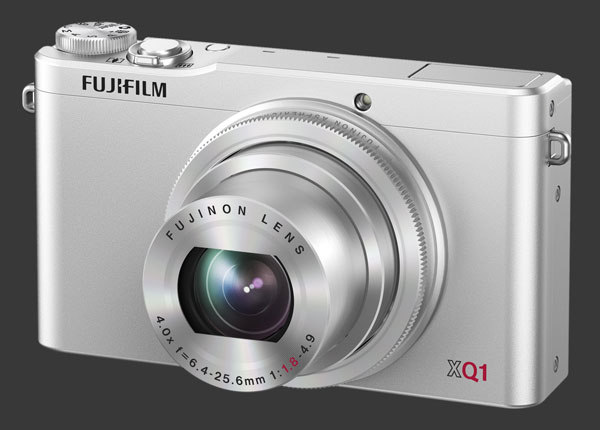
Dual control-dials make the Fuji XQ1 quite efficient. The large front-dial which surrounds the lens barrel is very ergonomic and within easy reach when holding the camera using both hands. It turns smoothly but with some resistance to avoid accidental changes. Unlike most such dials, this one rotates freely without detents which is suitable for Manual Focus but not ideal for other parameters.
The default Standard configuration is to have the front control-dial set the main exposure parameter. In Manual mode that means Aperture, while the rear-dial controls Shutter-Speed. In P mode, it operates Program-Shift. In all modes, by default, both dials perform the same action, making the rear one largely redundant except when assigning another operation to the front-dial.
The front control-dial can be set to control a different parameter by pressing E-Fn and turning either control-dial. There are 7 options to choose from:
- Standard: Controls an exposure parameter, depending on the mode, as described already.
- EC: Dials Exposure-Compensation in 1/3 EV steps. Does nothing in Manual mode, so one has to use the rear EC button to switch between exposure parameters there.
- ISO: Dials ISO in 1/3 EV steps or selects Auto ISO according to how it is configured in the menu. The XQ1 shows which maximum sensitivity is allowed.
- WB: Cycles over White-Balance settings, including Custom WB. To set Custom WB or WB Fine-Tuning, using the menu is still needed.
- Film Simulation: Choose between Film Simulation modes.
- Continuous: Cycles over all possible drive modes, including 4 speeds of continuous shooting.
- Zoom: Adjusts the focal-length in very fine increments and activates digital zoom beyond the maximum zoom. Notice how the lens moves and makes a sound before digital zoom is engaged. If it is silent while zooming, you have gone too far!
Overall this system of control-dials is nice. Most people are likely to leave it on Standard or Zoom, depending if they work principally in an automatic mode or not. Where this could be improved is if the rear control-dial was also customizable to recover from losing access to a feature by assigning the front control-dial to something else than Standard. For most users, it would have been ideal to have the front dial control the main exposure parameter and the rear one controlling ISO.
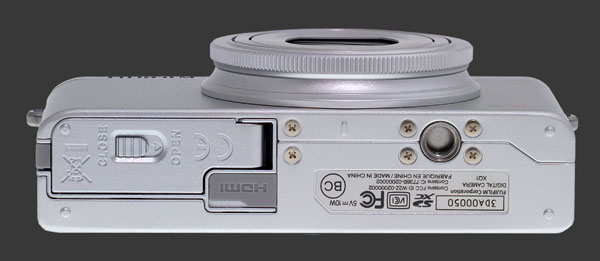
The bottom of the XQ1 has a poorly-placed metal tripod mount. With a small tripod head, it may be possible to change memory and batteries without removing the camera.
Unliked the Fuji XF1 which has a unique design with its collapsible mechanical-zoom, the XQ1 is by all means a traditional premium compact. Most competitors feature similar design and, ergonomically speaking, the XQ1 matches expectations and provides a similar level of usability.
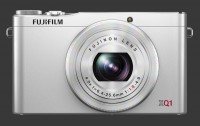 |
Please Support Neocamera
All information on Neocamera is provided free of charge yet running this website is a huge endeavor. Purchases made via affiliate links found throughout the site help keep it running and up-to-date. There is no additional cost to you, so please consider buying via these links to our affilates:
If you found any information on this site valuable and did not purchase via our affiliate links, please considering donating via PayPal:
Any amount will be greatly appreaciated. Thank you for your support!
Fujifilm XQ1 Highlights

Sensor-Size: 9 x 7mm

Actual size when viewed at 100 DPI
| 12 Megapixels Fixed Lens | ISO 100-12800 |
| 4X Ultra-Wide Optical Zoom | Shutter 1/4000-30s |
| Built-in Stabilization | Full manual controls, including Manual Focus |
| 1 Axis Digital Level | Custom white-balance |
| 12 FPS Drive, 8 Images | Spot-Metering |
| 1920x1080 @ 60 FPS Video Recording | Lithium-Ion Battery |
| 3" LCD 920K Pixels | Secure Digital Extended Capacity |
Updates
2025.01.18

Fujifilm GFX 2025 Lens Roundup
Lens Review roundup of Fujifilm GFX Medium-Format lenses. Quality, performance and handling of the GF20-35mm F/4R WR, GF30mm F/3.5 Tilt-Shift and the GF55mm F/1.7.
2024.11.18

Best 2024 Photography Gifts for Every Budget
Great gifts for photographers and photo enthusiasts selected for every budget among the best products of 2024.
2024.08.07

Eye Protection Tips for Professional Photographers
The four main considerations for professional photographers regarding eyewear.
2024.07.14

Fujifilm X100VI Review
Flagship fixed-lens compact digital camera with a 40 MP sensor and Image-Stabilization, a first for the series. Retro design featuring dual control-dials, plus direct ISO, Shutter-Speed and EC dials. Its hybrid viewfinder can switch between EVF and OVF mode.
2024.05.09

Fujifilm GFX100 II Review
Flagship 102 Megapixels Medium-Format Mirrorless Digital Camera with 8-Stop 5-Axis IBIS, 8 FPS Drive, 8K Video and 400 MP Super-Resolution capture in a weatherproof and freezeproof body with dual control-dials and dual memory-card slots.
2024.04.03

Fujifilm X-T5 Review
Newest Fujifilm flagship boasting a 40 MP APS-C sensor, 5-axis IBIS with 7-stop efficiency, 15 FPS continuous drive, 6.2K Video capture, dual control-dials and dual SDXC UHS-II slots in a sturdy weatherproof and freezeproof body.
2023.11.20

Best Digital Cameras of 2023
Find out which are the Best Digital Cameras of 2023. All the new Mirrorless Digital Cameras from entry-level to high-end professional.
2023.07.10

Fujifilm X-H2 Review
40 Megapixels APS-C Hybrid Mirrorless Digital Camera with 7-stop IBIS. Fastest shutter ever and 8K video capture. Large builtin EVF with 0.8X magnification and 5.8 MP, plus an Eye-Start Sensor. Packed with features and large number of controls in a weatherproof and freezeproof body.
2023.05.07

Sony FE 20-70mm F/4G Review
Review of the unique Sony FE 20-70mm F/4G lens. The optical zoom of this lens spans ultra-wide-angle and medium focal-length coverage, making it one of the most versatile Full-Frame lenses on the market.
2023.01.15

Huion Inspiroy Dial 2 Review
Review of the Huion Inspiroy Dial 2 tablet, a medium sized drawing surface with dual dials and customizable buttons. Connects via USB-C or Bluetooth 5.0 with Windows, Linux and Android support.
2022.12.08

How to Pack for a Photo Trip
Find out how to pack for a travel photography trip, carry your gear safely while meeting airline regulations.
2022.11.13

Best Digital Cameras of 2022
The best digital cameras of 2022. A short list of the most outstanding models in their respective categories. Choose one for yourself or as a gift.














